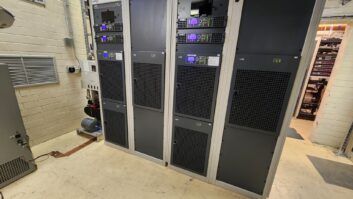Backup power
Oct 1, 2000 12:00 PM, Kirk Harnack
When was the last time the lights went out at your radio station? Last summer? Last winter? A year ago? Depending on your luck or your good planning, you may have never experienced an outage.
More and more station engineers, managers and owners are placing a priority on reliable power systems, and some of them are working quite well. Backup power systems are keeping stations on the air when utility companies are scrambling for work crews. Backup power systems keep the audience and the revenue streams firmly in place when commercial power providers drop the ball.
The decision process In most cases, the decision to install backup power is a purely economic one. Top stations in large markets can purchase a complete backup power system with the gross revenue from one or two morning shows. For medium and smaller markets, the costs are much higher compared to the station’s revenue. Generator sets (gensets) aren’t getting any cheaper. However, uninterruptible power supplies (UPSs) have become very affordable. Consolidation of studio sites and transmission facilities is lowering the cost of power redundancy, too.
Not all broadcast engineers are experts in backup power systems. There is much to be learned from other engineers with considerable experience in the art of designing, implementing and maintaining such systems.
Entercom Communications installs UPS systems for two purposes: to provide clean power and short-term backup power to permit continued operations during the transition to an emergency generator or other power source. Many studio buildings suffer from significant AC line noise caused by elevator motor SCR controllers, high-capacity photocopiers, microwave ovens and other sources of electro-magnetic interference. For master-UPS installations, one of the most important features to include is a make-before-break or hot-bypass switch. This will permit servicing the UPS batteries without taking the system completely down. Usually the installing electricians hook this up.
Entercom also has found that many UPS units respond poorly to slightly off-frequency generator sets (a condition that is not unusual during engine warm-up), with the result being that although the generator is running, the UPS does not charge. This leads to a UPS failure. Although it is not always the case, the frequency-lock window for the UPS sensor often is adjustable and can compensate for the variation.
Entercom usually includes the on-air studios, news studios, audio delivery systems, traffic/billing systems, the LAN, STL and the telephone system on the master UPS. Also, many digital audio processors have a long recycle time. To avoid unnecessary program dropouts, these are kept on the UPS system. Smaller UPS units are used at the transmitter sites to support the microwave receivers, digital processors and remote-control units through the transition cycles of the emergency power generator.
Stormy weather Like many Florida stations, Clear Channel of Panama City is frequented by fierce lightning and hurricanes. For this six-station installation, an 18kVA UPS feeds 120VAC to a separate power-distribution panel. This panel feeds all the on-air and production rooms, engineering rack room (with six racks full of STLs, RPUs, remote controls and processing), lighting in the control rooms and restrooms, and all the on-air computer systems. This UPS also feeds the file server and mail server connected to the Clear Channel WAN. When commercial power flickers, everything keeps running. In most cases, the on-air talent isn’t aware of the failure.
The entire load listed above uses about 63 percent of the UPS’s capacity. While the system can sustain the facility for 25 to 30 minutes, it never has run for more than one minute because the 200kW generator automatically transfers to power the entire building, including the air conditioning. The capacity to run everything, including the VHAC, is important because hurricanes and other tropical storms are so common. A regular maintenance program is important for generators and UPSs. Most newer generators provide automatic testing.
Brownouts and blackouts Critical on-air systems should have UPS support to maintain operation until a generator can pick up the load. For multi-station or clustered groups, a large, central UPS is the best way to accomplish this. KDMX and KEGL in Dallas have such a system and are a good example of emergency power planning on a large scale.
The Clear Channel Dallas facility uses a 27-amp UPS to power the critical systems in the engineering shop such as automation servers, audio processors, T1 and RF STLs, and the office phone system. In the control rooms, smaller UPS systems handle the console, CD players, EAS and remote controls.
At the transmitters, Clear Channel Dallas has a UPS on the remote control system and a digital exciter, which requires a long time to reboot after a power loss. A generator provides extended backup-power support of the transmitters and HVAC. At one of the Clear Channel Dallas transmitter sites, two independent high-voltage feeds are provided from the local utility grid. These are switched automatically should one feeder go dead.
When planning to install or upgrade a backup power system, consider the amount of power that will be needed and the duration. Should one large UPS be used for powering on-air and computer equipment, or should several smaller units be distributed to necessary areas? How much load should a genset carry? Should HVAC be included? What fuel system is best for each generator installation? Local zoning laws, station economics and physical space will all affect the decision.












